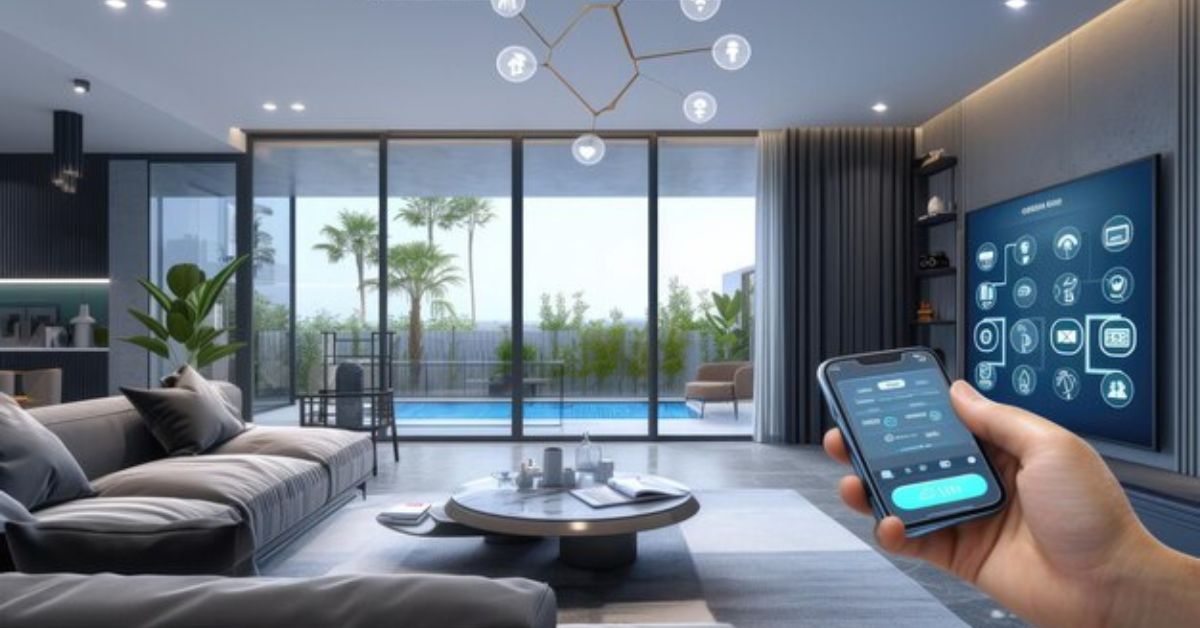Over the past ten years, the idea of “smart homes” has quickly gained popularity and changed the way we use our living areas. The efficiency, convenience, and security of homes are being improved by this technological revolution, which is changing daily life. Home automation has evolved from a specialized trend to a common way of life with the introduction of IoT (Internet of Things) devices. However, what are smart houses and how do they operate? Let’s explore this fascinating subject to see how smart houses are transforming contemporary living.
Smart Homes: What Are They?
A home that has gadgets that can be operated from a distance via the internet is called a “smart home.” These gadgets are commonly integrated with artificial intelligence (AI), allowing them to learn and adapt to the user’s preferences over time. Enhancing convenience, security, energy efficiency, and entertainment while streamlining daily chores is the primary objective of smart homes. The options are endless, ranging from sophisticated security systems to smart lighting and thermostats.
Core Components of Smart Homes
To better understand the ecosystem of a smart home, it’s important to break down the core components that make it functional. Below are some of the key categories of smart home technology:
1. Smart Lighting
Smart lighting systems allow homeowners to control their lights remotely via mobile apps or voice commands. These systems can be programmed to adjust based on time of day, occupancy, or even environmental factors like natural light. Popular examples include Philips Hue and LIFX smart bulbs, which offer both energy savings and convenience.
2. Smart Thermostats
Smart thermostats like the Nest Learning Thermostat or Ecobee are designed to optimize energy consumption. These devices adjust the temperature based on your routines, learning your preferences over time to provide a comfortable home environment while lowering energy costs.
3. Smart Security Systems
Thanks to smart technology, home security has undergone a significant transformation. From indoor and outdoor cameras (like Arlo) to video doorbells (like Ring), these systems provide real-time monitoring, alerts, and even remote interaction with intruders. For an extra degree of security, many smart security systems can be integrated with motion detectors, smart locks, and other safety features.
4. Smart Speakers and Voice Assistants
Devices like Amazon Echo and Google Nest Hub serve as the brains of many smart homes. These voice assistants allow users to control other smart devices, play music, set reminders, and perform countless other tasks simply by using voice commands.
5. Smart Appliances
Home appliances have also become “smart.” Refrigerators, washing machines, dishwashers, and ovens are now available with advanced features such as remote control, energy monitoring, and alerts for maintenance needs. Brands like Samsung and LG have pioneered this category with products designed to offer enhanced functionality and user-friendliness.
6. Smart Home Hubs
A smart hub works as the central control point for controlling all the connected devices in a smart home. These hubs, such as Samsung SmartThings, Apple HomeKit, or Amazon Alexa, allow users to build routines, automate operations, and sync devices for more seamless control.
Advantages of Smart Homes
The popularity of smart homes can be attributable to the various advantages they offer. Here are some of the primary benefits:
1. Increased Convenience
Smart homes automate everyday tasks, reducing the need for manual intervention. You can control your lights, thermostat, and even your coffee maker from anywhere, whether you’re at work or on vacation. These automations save time and effort, making life easier.
2. Improved Energy Efficiency
By adjusting systems like heating, cooling, and lighting based on usage patterns, smart homes can optimize energy consumption, leading to lower utility bills. For instance, a smart thermostat can ensure your home is not wasting energy while you’re away. Smart lighting can turn off when a room is unoccupied, further contributing to energy savings.
3. Enhanced Security
Smart security devices offer real-time monitoring and alerts, allowing homeowners to stay connected to their property at all times. Whether it’s watching live footage from security cameras or remotely locking doors, the security features provide peace of mind and greater control over the safety of the home.
4. Better Control Over Home Environment
Smart thermostats, for example, not only adjust temperatures based on user preferences but can also anticipate adjustments based on weather forecasts. Air quality monitoring systems can help ensure that your home’s environment remains healthy. With smart lighting, you can adjust the ambiance based on your mood or activity.
5. Entertainment and Comfort
From controlling your entertainment systems via voice commands to syncing music throughout different rooms, smart homes offer unparalleled convenience for entertainment lovers. Smart televisions, speakers, and home theater systems allow for a seamless media experience that can be controlled from a single device.
Challenges and Considerations for Smart Homes
While smart homes offer numerous benefits, there are a few challenges and considerations to keep in mind when adopting this technology:
1. Privacy Concerns
Since smart devices are connected to the internet, there is always a risk of data breaches. Devices like smart speakers or cameras are constantly collecting data, which could be vulnerable to hacking. It’s important to choose reputable brands and implement strong security measures, such as two-factor authentication.
2. Interoperability Issues
Not all smart home devices work seamlessly together. With various platforms like Amazon Alexa, Google Assistant, and Apple HomeKit, compatibility between devices can sometimes be an issue. Before purchasing, ensure that the devices you choose are compatible with your existing systems or plan for an integrated smart home hub.
3. Initial Cost
Although the long-term savings are substantial, the upfront cost of installing a smart home system can be expensive. Devices like smart thermostats, cameras, and home hubs require an initial investment that may not be feasible for all homeowners. However, many devices offer gradual integration, allowing users to build their smart homes over time.
4. Dependence on Internet Connectivity
Since most smart devices rely on internet connectivity, your home automation system may be impacted by issues like internet outages or slow speeds. Having a stable and fast internet connection is crucial to ensuring optimal performance.
Popular Smart Home Ecosystems
When it comes to choosing the right ecosystem for your smart home, there are several options available, each offering a different set of features and device compatibility. Below are the most popular smart home ecosystems:
1. Amazon Alexa
Amazon’s Alexa ecosystem is one of the most versatile in the market. It supports thousands of third-party devices and offers a robust voice assistant that can control almost every aspect of your smart home. With Alexa, you can easily add devices, create routines, and integrate multiple smart products.
2. Google Assistant
Google Assistant offers a more straightforward setup process and is compatible with a wide range of smart home devices. While it may not be as expansive as Alexa in terms of third-party integrations, Google Assistant provides excellent voice recognition and control.
3. Apple HomeKit
For those already invested in the Apple ecosystem, HomeKit is a natural choice. HomeKit ensures a high level of privacy and security, with a focus on seamless integration with Apple devices like the iPhone, iPad, and Apple Watch.
4. Samsung SmartThings
Samsung’s SmartThings hub offers broad compatibility with both third-party devices and smart home appliances. This ecosystem is great for users looking to integrate various smart devices into one unified system.
Smart Home Comparison Chart
Here’s a comparison chart outlining key features of the major smart home ecosystems:
| Feature | Amazon Alexa | Google Assistant | Apple HomeKit | Samsung SmartThings |
| Voice Control | Yes | Yes | Yes | Yes |
| Device Compatibility | Extensive | Moderate | Limited | Extensive |
| Privacy & Security | Moderate | High | Very High | High |
| Setup Process | Easy | Easy | Complex | Moderate |
| Integration with Third-party Devices | High | Moderate | High | Very High |
| Popular Devices | Echo, Fire TV | Google Nest, Home Hub | HomePod, Apple TV | SmartThings Hub, TVs |
Upcoming Developments in Smart Home Technology
With continuous developments in artificial intelligence, machine learning, and connectivity, the future of smart homes is bright. Among the most intriguing tendencies are:
1. AI Integration: As AI gains more insight into user behavior and anticipates their needs, homes will continue to get smarter.
2. Enhanced Energy Efficiency: By assisting homeowners in lowering their energy usage, smart homes will be essential in combating climate change.
3. speech and Gesture Control: To make gadgets easier to use, the upcoming generation of smart homes will have even more advanced speech and gesture controls.
4. Healthcare Integration: As medical gadgets and health sensors are integrated, smart homes may soon provide health monitoring services to help inhabitants’ wellbeing.
Conclusion
Millions of people are adopting smart homes today, making them a reality rather than a sci-fi idea. Smart homes are revolutionizing our way of life, from the ease of remote gadget control to the energy savings provided by intelligent systems. The potential for improving home life is almost endless as technology develops further. Before committing to a completely automated living environment, it is crucial to thoroughly evaluate privacy, compatibility, and costs. You may make well-informed judgments about incorporating smart home technology into your life by being aware of its essential elements, advantages, and any drawbacks.







